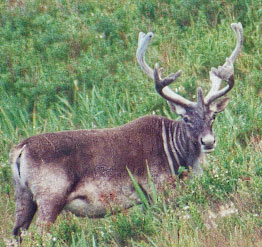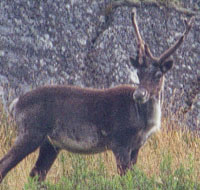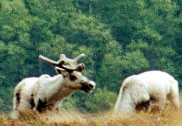CoastalSafari@
CoastalSafari.com
Telephone
1-877-888-3020 (Toll free) or
709-579-3977
Mailing Address
50 Monkstown Rd. St. John's, Nfld. Canada. A1C 3T3

The Coastal Safari camp is an ideal place to view woodland caribou because it is located next to the largest wilderness reserve on the island of Newfoundland, the Bay Du Nord Reserve (2895 sq km). In the Reserve all development, cabins and mechanized vehicles are prohibited and as a result the Middle Ridge caribou herd which breeds and winters there is the largest herd on the island.
The slow growing lichens of the barrens are the mainstay of the caribou's winter diet, though a variety of other green plants are available during the summer months. A caribou eats about five kilograms of lichens each day, favouring the grey varieties, known commonly as caribou moss. Adult females can weigh up to 135 kilograms, while males can reach 270 kilograms.
The herd spends winters throughout the central portion of the Reserve seeking shelter in the forests to the north during especially severe winters. As calving season approaches in late May, the herd divides with the females move to the calving grounds in the northwest and southeast of the Reserve. The adult males and other non-breeding caribou disperse throughout the range.

The majority of the herd migrate southward for the summer, seeking the
cool breezes of the coast. This is when we see them around the Coastal
Safari camp. Females and their new calves follow the route taken by
the rest of the herd, arriving at the summer feeding areas during July and
August. During late August to early September, the herd begins its travel
back to the wintering grounds, where during October and November courtship
and mating takes place.
At the last census in 1995 government wildlife biologists estimated
the herd to be 19,765 animals.  The Middle Ridge herd has grown considerably during the past twenty
years and its range has expanded. Local residents recall that thirty years
ago a caribou sighting along the coast was uncommon and years ago hunters
had to travel far into the country to find caribou that were an essential
staple food for fishing families. Today caribou are everywhere along the
north side of Fortune Bay. On our boat trip from Harbour Mille to the
Coastal Safari camp it is common to see caribou standing motionless
on the barren hill tops silhouetted against the sky.
The Middle Ridge herd has grown considerably during the past twenty
years and its range has expanded. Local residents recall that thirty years
ago a caribou sighting along the coast was uncommon and years ago hunters
had to travel far into the country to find caribou that were an essential
staple food for fishing families. Today caribou are everywhere along the
north side of Fortune Bay. On our boat trip from Harbour Mille to the
Coastal Safari camp it is common to see caribou standing motionless
on the barren hill tops silhouetted against the sky.
Newfoundland government biologist Shane Mahoney theorizes that as the herds increase the animals retain information about where they came from. This information evolves as animals use new locations and these locations then become part of the new range used by the growing herd.
Basically caribou are very adaptable and move easily to areas where
there is suitable habitat. To date the condition of the Middle Ridge herd
is very healthy with no sign of nutritional stress as the herd is extending
its range. Historically the main predator of Newfoundland caribou was
the Newfoundland Wolf
(Canis lupus beothucus) but it has been extinct since around
1930. Currently the principal predators are humans and to a lesser extent
bears and lynx. It is unknown what effect coyotes will have on caribou.
Coyotes crossed the 90 mile wide Cabot Strait from Nova Scotia to Newfoundland
on the spring pack ice in the mid 1980's.  The first documented case of a coyote in Newfoundland was in 1987, as
a result of a highway kill near Deer Park on Newfoundland's west coast
. It has been observed that as a herd gets larger it is less likely to see
large animals. Caribou turn white during the winter and then shed their
winter coat during the spring and early summer.
The first documented case of a coyote in Newfoundland was in 1987, as
a result of a highway kill near Deer Park on Newfoundland's west coast
. It has been observed that as a herd gets larger it is less likely to see
large animals. Caribou turn white during the winter and then shed their
winter coat during the spring and early summer.
Sources
2. Bay Du Nord Wilderness Reserve User's Guide - Publication Number 34. Department of Tourism and Culture, Parks Division, Government of Newfoundland & Labrador, 1983.
3. John E. Maunder, The Newfoundland Wolf , Museum
Notes No. 8 Newfoundland Museum,1999.
![]()
